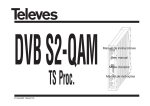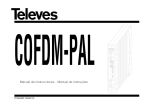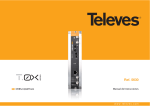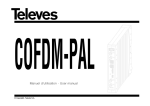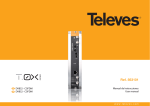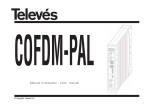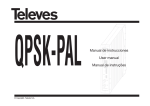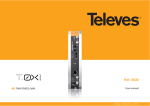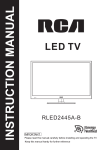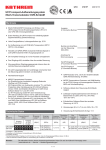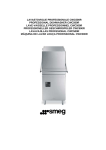Download Manual de instrucciones User manual
Transcript
COFDM-QAM © Copyright, Televés S.A. Manual de instrucciones User manual COFDM-QAM ESPAÑOL Manual de instrucciones INDICE 1. Características técnicas . . . . . . . . . . . . . . . . . . . . . . . . . . . . . . . . . . . . . . . . . . . . . . . . . . . . . . . . . . . . . . . . . . . . . . . . . . 2. Descripción de referencias . . . . . . . . . . . . . . . . . . . . . . . . . . . . . . . . . . . . . . . . . . . . . . . . . . . . . . . . . . . . . . . . . . . . . . . . 6 3. Montaje . . . . . . . . . . . . . . . . . . . . . . . . . . . . . . . . . . . . . . . . . . . . . . . . . . . . . . . . . . . . . . . . . . . . . . . . . . . . . . . . . . . . . . . 7 3.1. Montaje en libro 4. 5. 4 ............................................................................ 7 3.2. Montaje en Rack 19” . . . . . . . . . . . . . . . . . . . . . . . . . . . . . . . . . . . . . . . . . . . . . . . . . . . . . . . . . . . . . . . . . . . . . . . . . 8 Descripción de elementos 9 ........................................................................ 4.1. COFDM-QAM . . . . . . . . . . . . . . . . . . . . . . . . . . . . . . . . . . . . . . . . . . . . . . . . . . . . . . . . . . . . . . . . . . . . . . . . . . . . . . 9 4.2. Fuente alimentación ......................................................................... 11 4.3. Central amplificadora ........................................................................ 12 4.4. Programador PCT 4.0 . . . . . . . . . . . . . . . . . . . . . . . . . . . . . . . . . . . . . . . . . . . . . . . . . . . . . . . . . . . . . . . . . . . . . . . . 13 Manejo del producto . . . . . . . . . . . . . . . . . . . . . . . . . . . . . . . . . . . . . . . . . . . . . . . . . . . . . . . . . . . . . . . . . . . . . . . . . . . . . 14 5.1. Menú principal . . . . . . . . . . . . . . . . . . . . . . . . . . . . . . . . . . . . . . . . . . . . . . . . . . . . . . . . . . . . . . . . . . . . . . . . . . . . . . 14 5.2. Menú extendido . . . . . . . . . . . . . . . . . . . . . . . . . . . . . . . . . . . . . . . . . . . . . . . . . . . . . . . . . . . . . . . . . . . . . . . . . . . . . 15 5.3. Grabando parámetros . . . . . . . . . . . . . . . . . . . . . . . . . . . . . . . . . . . . . . . . . . . . . . . . . . . . . . . . . . . . . . . . . . . . . . . . 16 6. Ejemplo de distribución de 5 canales de COFDM . . . . . . . . . . . . . . . . . . . . . . . . . . . . . . . . . . . . . . . . . . . . . . . . . . . . . . 17 7. Normas para montaje en rack . . . . . . . . . . . . . . . . . . . . . . . . . . . . . . . . . . . . . . . . . . . . . . . . . . . . . . . . . . . . . . . . . . . . . . 18 8. Normas para montaje en cofre . . . . . . . . . . . . . . . . . . . . . . . . . . . . . . . . . . . . . . . . . . . . . . . . . . . . . . . . . . . . . . . . . . . . . 20 A. Tablas de canales . . . . . . . . . . . . . . . . . . . . . . . . . . . . . . . . . . . . . . . . . . . . . . . . . . . . . . . . . . . . . . . . . . . . . . . . . . . . . . . 43 3 Manual de instrucciones COFDM-QAM 1.- CARACTERISTICAS TECNICAS 1.1.- COFDM-QAM ref. 5056 Pérdidas paso entrada: Frecuencia de entrada: Desmodulador COFDM Alimentación previos: Filtro SAW entrada: Pasos de frecuencia: Margen de enganche: Formato de modulación: Modulador QAM Velocidad de símbolo : Factor de roll-off : Frecuencia de salida: Salida RF General Pasos de frecuencia: Nivel de salida máximo: Consumos: < 1.2 dB 174-230 MHz (BIII) / 474-858 MHz (UHF) o tablas de canales CCIR Seleccionable 0V-12V-24V (<60mA) 7 - 8 MHz 1 MHz ± 500 KHz Nivel de entrada: ROE de entrada (75 ohm): FFT: Constelación: Intervalo de guarda: Tasa de Viterbi: Estándar transmisión: -60 a –20 dBm (8K, 64 QAM, FEC 2/3) > 12 dB (46 - 862 MHz) 2K, 8K QPSK, 16 QAM, 64 QAM 1/4, 1/8, 1/16, 1/32 1/2, 2/3, 3/4, 5/6, 7/8 ETS300744 16QAM, 32QAM, 64QAM, 128QAM, 256QAM Máx. 7.2 Mbaud 15% Código de bloque: Scrambling Interleaving: Espectro de salida: RS(188, 204) ETS300429 Normal / Invertido (seleccionable) 46 - 862 MHz o tablas de canales 250 KHz 80 dBµV ±5 dB Margen de regulación: ROE de salida (75 ohm): Pérdidas de paso: Nivel espúreos en banda: 15 dB min. 10 dB min. 14 dB tip. < 1.5 dB (46-862 MHz) 55 dBc min. 60 tip. 5V: 0,6 A 15V: 0,35 A Las características técnicas descritas se definen para una temperatura ambiente máxima de 40°C 4 Manual de instrucciones COFDM-QAM Central Rango de frecuencia: Ganancia: Margen de regulación: Tensión de salida (60 dB): 47 ... 862 MHz 45 ± 2 dB 20 dB 105 dBµV (42 CH CENELEC) Conector: Alimentación: Consumo a 15 V: Toma de test: “F” 15 V 750 mA -30 dB 47 ... 862 MHz 44 dB 20 dB 104 dBµV (42 CH CENELEC) Conector: Alimentación: Consumo a 24 V: Toma de test: “F” 230 V~ 430 mA -30 dB Corrientes máximas suministradas: 24V 18V 15V 5V 1 . 3.- Características técnicas Central ref. 4510 Central Rango de frecuencia: Ganancia: Margen de regulación: Tensión de salida (60 dB): 1 . 4.- Características técnicas Fuente Alimentación ref. 5029 Fuente alimentación Tensión de entrada: Tensiones de salida: 230 ± 15 % V~ 5V, 15V, 18V, 24V (1) Si utiliza las tensiones de 24V y/o 18V, deberá restar la potencia consumida por éstas a la potencia de los 15V. 5 (0,55 A) (0,8 A) (4,2 A)(1) (6,6 A) ESPAÑOL 1 . 2.- Características técnicas Central ref. 5075 Manual de instrucciones COFDM-QAM 2.- DESCRIPCION DE REFERENCIAS Ref. 5056 .... COFDM-QAM (174 - 230 / 474 - 858 MHz) Ref. 7234 .... Programador Universal Ref. 5075 .... Central A. T-05 (47 - 862 MHz) Ref. 5071 .... Soporte universal 10 mod + Alim. Ref. 4510 .... Central Kompact (47 - 862 MHz) Ref. 5239 .... Soporte T40/T50 12 mod + Alim. Ref. 5029 .... F. Alimentación (230 V ± 15 % - 50/60 Hz) (24 V - 0,55 A) (18 V - 0,8 A) (15 V - 4,2 A)(1) (5 V - 6,6 A) Ref. 8250 .... Subrak 19’ Ref. 5301 .... Anillo subrack 19” Ref. 5072 .... Cofre universal Ref. 4061 .... Carga “F” 75 ohm bloqueada DC Ref. 4058 .... Carga “F” 75 ohm sin bloquear DC Ref. 5073 .... Placa supl. ciega Ref. 5253 .... Latiguillo interconex. bus datos Ref. 5255 .... Latiguillo interconex. T03/T05 Ref. 5334 .... Unidad de ventilación Ref. 5301 Ref. 5072 Ref. 8250 (1) Si utiliza las tensiones de 24V y/o 18V, deberá restar la potencia consumida por éstas a la potencia de los 15V. 6 Manual de instrucciones COFDM-QAM ESPAÑOL 3 .- MONTAJE 3.1.- Montaje en libro Entrada COFDM a a 5056 5075 5029 CLAC! COFDM-QAM COFDM-QAM COFDM-QAM COFDM-QAM 1 CTRL CTRL CTRL CTRL PWR PWR PWR PWR PWR 5071 5239 2 PC 105366 T4 .0 A UN IVE B RS C Salida QAM AL 4061 7234 7 Manual de instrucciones COFDM-QAM 3.2.- Montaje en rack 19” CLAC! COFDM-QAM COFDM-QAM 5301 5073 8 COFDM-QAM COFDM-QAM Manual de instrucciones COFDM-QAM ESPAÑOL 4. - DESCRIPCION DE ELEMENTOS 4.1.- COFDM-QAM 1 1.- Entrada RF + DC (COFDM) COFDM-QAM 2.- Salida RF (COFDM) 3.- Entrada RF (QAM) 2 4.- Salida RF (QAM) 5.- Conector programador / PC 5 6 8 3 6.- Entrada alimentación módulo 7.- LED de estado 7 8.- Conector BUS de control RS-485 Alimentación 24V 4 COFDM-QAM Indicar el canal de entrada programado Referencia producto Indicar el canal de salida programado Ch 9 Anotar la dirección del dispositivo en el Control de Cabecera (001 ... 254) Manual de instrucciones INTRODUCCIÓN Con la aparición de los servicios de televisión digital terrestre en un formato de modulación, COFDM, distinto del utilizado para satélite (QPSK) y cable (QAM), el usuario debe utilizar para la visualización de los citados servicios un receptor específico, IRD de COFDM, compuesto básicamente por un Desmodulador de COFDM y descodificador de MPEG. Esta inconveniencia podría solventarse distribuyendo la señal de COFDM mediante una transmodulación COFDM-PAL, con lo que se utilizaría el mismo aparato de televisión para la recepción de servicios digitales, evitando de esta forma la compra de un IRD específico. Este método presenta el inconveniente de que con la transmodulación al formato analógico PAL se pierden las características de calidad y servicios de valor añadido que acompañan a la televisión en formato digital. Por otra parte, el Proyecto DVB, a través de la norma ETS300473, establece el formato de modulación QAM como uno de los formatos de distribución de señales digitales en redes de SMATV, por sus características de robustez frente a ruido y desadaptaciones así como por su alta eficiencia espectral. Según esta norma, las señales de televisión vía satélite son distribuidas en redes COFDM-QAM de SMATV mediante transmoduladores transparentes, que convierten el formato de modulación de satélite, QPSK a QAM. up-converter ágil. Mediante el programador universal (ref.7234) se realiza la programación de los parámetros de funcionamiento del transmodulador COFDM-QAM (canal de entrada, canal de salida y formato de modulación principalmente). DESCRIPCIÓN DEL PRODUCTO El trasmodulador COFDM-QAM ref. 5056 permite también la alimentación de previos a través de su entrada. El usuario puede elegir, mediante el mando programador, dos tensiones de alimentación, 12 voltios y 24 voltios, o bien inhabilitar la alimentación. Este método de conversión de formato de modulación o transmodulación puede ser asimismo utilizado para la distribución de señales digitales terrestres en redes de SMATV. Así, el transmodulador digital COFDM-QAM ref. 5056 permite la distribución de los servicios de valor añadido de la señal digital (mejora de calidad audiovisual, subtitulado, sonido multilenguaje, interactividad...). Para la recepción de la señal podría utilizarse el mismo IRD que se utiliza para la recepción de los canales transmodulados de satélite, por lo que solamente sería necesario un IRD de QAM para la recepción de ambas señales digitales (satélite y terrestre) y no se produciría merma de calidad por transmodulación a formato analógico. Para ello, el transmodulador COFDM-QAM ref.5056 recibe un canal digital terrestre en formato COFDM y lo demodula obteniendo un paquete de transporte MPEG-2. Posteriormente el paquete de transporte MPEG2 es modulado en formato QAM y convertido al canal de salida utilizando un 10 El formato físico del transmodulador COFDM-QAM, T05, permite la perfecta integración con los restantes elementos de distribución de Televés, tales como moduladores, transmoduladores analógicos PAL, transmodulador digital QAM y procesadores analógicos y digitales. Finalmente, el transmodulador COFDM-QAM dispone asimismo del interfaz RS485, lo que permitirá en un futuro su integración en el sistema de control de cabecera desarrollado por Televés. COFDM-QAM 4.2.- Fuente de alimentación (1) (1) PWR + 18V + 15V + 5V + 24V GND N/C LED encendido PWR PWR Conectores para alimentar los módulos (1) NOTA: La fuente de alimentación puede alimentar un máximo de 5 módulos COFDM-QAM. Entrada RED 230V~ 11 ESPAÑOL Manual de instrucciones Manual de instrucciones COFDM-QAM 4.3.- Central amplificadora OPCION “A” - 5075 OPCION “B” - 4510 6 1 2 TEST (-30dB) Amplificador CATV CATV Amplifier Test ent. Test in (-30dB) PWR 5 7 3 Entrada Input Test sal. Test out (-30dB) Salida Output 6 1 4 2 3 4 5 234632 1.- Salida RF 2.- Toma Test 3.- Entrada RF 4.- Entrada RF 1.- Test entrada 2.- Entrada RF 3.- Test salida 5.- Entrada alimentación módulo 6.- Atenuador 7.- LED de estado Dispone de dos conectores de entrada de señal, para permitir la mezcla de los canales suministrados por dos sistemas. Si se utiliza sólo una de las entradas, se recomienda cargar la entrada no utilizada con una carga de 75 ohm, ref 4061. Dispone de un conector de salida y una toma de Test (-30dB) situadas en la parte superior del panel frontal. La alimentación se realiza a 15V, a través de un latiguillo igual al utilizado para la alimentación de los otros módulos del sistema. 4.- Salida RF 5.- LED de estado 6.- Alimentación Central realizada en chasis zamak blindado, configurable en ganancia por el propio instalador. Esta referencia tiene su aplicación como amplificador de cabecera o línea en sistemas de CATV. La central amplificadora realiza la amplificación de los canales generados en los transmoduladores TDT, cubriendo el margen de frecuencias de 47 a 862 MHz. 12 Manual de instrucciones COFDM-QAM 4. 4. - Programador PCT 4.0 El programador consta de 4 teclas: : (pulsación corta) - Selección de parametro (posicionamiento del cursor). PCT 4.0 UNIVER SAL COF -QA M : (pulsación corta) - Cambio de menú. Ch A B : Modificación del parámetro (incremento/decremento) apuntando por el cursor (parpadeante). COFDM-QAM DM C : (pulsación larga) - Cambio entre menús principales y extendidos. : (pulsación larga) - Grabado de configuración en memoria + : Aumentar el contraste de la pantalla + + : Disminuir el contraste de la pantalla 105366 + 13 Manual de instrucciones COFDM-QAM 5. - MANEJO DEL PRODUCTO 5.1. MENU PRINCIPAL Insertar el programador en el conector frontal de programación del módulo COFDMQAM (“PRGM”). Aparecerá en primer lugar la versión de firmware del programador: PCT 4.0 firmware -----------Version 4.01 A continuación se muestra la versión de firmware del módulo COFDM-QAM Version de firmware unidad: V:3.00 a.- Menú entrada El primer menú principal permite seleccionar el canal o frecuencia de entrada (dependiendo del modo de funcionamiento), el ancho de banda de la señal de entrada (7-8 MHz) y la alimentación de previos (0, 12 ó 24V). Para realizar una modificación se deberá pulsar la tecla hasta que el parámetro deseado parpadee. Seguidamente se podrá modificar dicho campo mediante las teclas y . ENTRADA __ Frecuencia: 474MHz 8MHz Preamp: 0v En caso de que el menú se muestre en modo frecuencia (ver menú extendido) se seleccionará la frecuencia central del canal, siendo el paso mínimo de 1MHz. El rango permitido de valores de entrada es de 174 a 230 MHz (BIII) y de 474 a 858 MHz (UHF) ENTRADA __ CANAL:21 8MH (474.00 MHz) Preamp: 12v En la esquina superior izquierda se proporciona una estimación gráfica del nivel de entrada detectado: “--” Nivel bajo “--” Nivel normal “--” Nivel alto 14 En caso de “corto” en el conector de entrada (alimentación a previos habilitada) parpadea el led del frontal del módulo hasta que desaparezca esta condición. b.- Menú de modulación QAM El siguiente menú principal indica los parámetros de la modulación QAM seleccionada: QAM Mod: 64QAM IQ: normal Las posibles opciones para el orden de modulación QAM son: 16QAM, 32QAM, 64QAM, 128QAM y 256QAM. El parámetro IQ es la selección del formato de modulación y se puede escoger “normal” o “inversion”. c.-Menú de salida El siguiente menú principal muestra la frecuencia/canal de salida (dependiendo del modo de funcionamiento) y el control del nivel de salida. SALIDA Frec: 052.50 Nivel: 99 Salida:Norm. El rango de frecuencia de salida es 47-862 MHz. El control de nivel de salida puede seleccionarse entre 00 y 99. Parámetro Formato de salida, consta de las siguientes opciones : Norm: salida normal CW: sólo portadora OFF: salida cortada Para modificar la frecuencia se deberá pulsar la tecla hasta situar el cursor en el dígito seleccionado. La modificación se realiza mediante las teclas y . Como decimal de la frecuencia de salida solamente se permite seleccionar los valores siguientes: => .00 MHz => .25 MHz => .50 MHz => .75 MHz COFDM-QAM Para modificar el canal de salida, el control de nivel y el formato de salida se deberá pulsar la tecla hasta situar el cursor en el campo deseado, el cual se modificará mediante las teclas y . SALIDA Ch:21 474.00 Nivel: 99 Salida:Norm. Este dato es de utilidad a la hora de realizar la programación de IRD en los que se necesite conocer exactamente la velocidad de símbolo de la modulación QAM. 5.2.- MENU EXTENDIDO Para cambiar entre modo frecuencia y modo canal ver punto 6.2. MENU EXTENDIDO. Cuando se mantiene pulsada la tecla durante más de 3 segundos la unidad muestra una serie de menús de uso menos frecuente llamados menús extendidos. d. Menú medidas a. Menú parámetros COFDM Este menú muestra la siguiente información: estimación de la BER (bit error rate antes del decodificador de Viterbi), la medida de la temperatura en el interior de la unidad y el baud rate (velocidad de símbolo) real de QAM. Los parámetros de la transmisión COFDM se muestran en este menú: - Tamaño de la FFT (número de portadoras): 8K-2K. - Constelación (tipo de modulación): QPSK - 16QAM - 64QAM. - Intervalo de guarda: 1/4, 1/8, 1/16 o 1/32 - Tasa de Viterbi (coderate): 1/2, 2/3, 3/4, 5/6 o 7/8. MEDIDAS CBER: 7.0E-2 Temp: 37.5ºC QAM: 4.363 Esta tasa de salida vendrá fijada por la tasa de entrada de datos de COFDM y el orden de modulación QAM usado. 15 ESPAÑOL Manual de instrucciones Manual de instrucciones COFDM-QAM COFDM 8K - 64QAM Guard: 1/32 CodeRate:3/4 COFIG Dir CDC: 001 Modo por Frecuencia Si el modulador QAM no está enganchado se mostrará la siguiente pantalla. COFIG Dir CDC: 001 Tab Canales: CCIR N.Z.Ind COFDM Unlocked! b. Menú de configuración En este menú permite la selección la dirección de la unidad (para ser controlada a través de un Control de Cabecera CDC). Para que una cabecera pueda ser controlada remotamente cada dispositivo debe tener asignada una dirección única (1 a 254). Es responsabilidad del instalador asegurar que no existan direcciones duplicadas en el bus de control. También se puede seleccionar el modo frecuencia/tablas de canales. Las tablas de canales disponibles son: Table 1: CCIR, New Zealand and Indonesia. Italian channels. Table 2: China, Taiwan and CCIR hyperband. Table 3: M/N, Chile. Table 4: France. Table 5: Australia. Table 6: Southafrica, K1 (8MHz), I (Ireland, 8MHz). Table 7: Former URSS and OIRT. Para realizar una modificación se deberá pulsar la tecla hasta que el parámetro deseado parpadee. Seguidamente se podrá modificar dicho campo mediante las teclas y . 16 c.- Menú de idioma El último menú extendido permite seleccionar el idioma de los menús (español/inglés) IDIOMA Español Pulsando las teclas idioma seleccionado. o se cambia el 5.3.- GRABACIÓN DE PARÁMETROS Una vez escogido el valor deseado en cualquiera de los menús (normal o extendido), para grabar los datos se pulsará la tecla durante aproximadamente 3 segundos. El display mostrará la siguiente indicación: Grabando los parametros y rearrancando ... Si se modifican los datos de configuración pero no se graban, se recupera la configuración anterior transcurridos unos 30 segundos, es decir, se anulan los cambios realizados. Manual de instrucciones COFDM-QAM Entrada de señal de televisión digital terrestre COFDM (alimentación previos) 75 ohm 4061 5029 5 x 5056 cable 4 hilos 24 voltios (alimentación previos) Salida QAM En la figura se muestra el montaje para la distribución de 5 canales de COFDM. El bus de 4 hilos que conecta el primer elemento COFDM-QAM (conector CTRL.) a la fuente de alimentación 5029 (conector de 4 hilos marcado PWR) lleva la tensión de 24 voltios al elemento COFDM-QAM para la alimentación de previos a través del conector superior (entrada de señal). El resto de conectores de 4 hilos que interconectan los COFDM-QAM permiten que los elementos instalados sean controlables utilizando un controlador de cabecera ref.5052 y el software correspondiente. 17 ESPAÑOL 6.- EJEMPLO DE DISTRIBUCION DE 5 CANALES DE COFDM Manual de instrucciones COFDM-QAM 7.- NORMAS PARA MONTAJE EN RACK (max. 35 COFDM-QAM - 7 subracks de 5u. de altura - 8,7”) 7.1.- Instalación del rack con ventilación. Para favorecer la renovación y circulación del aire en el interior del rack reduciendo de esta manera la temperatura de las unidades y mejorando por ello sus prestaciones, se recomienda colocar 2 unidades de ventilación de 25W de potencia, sobre todo cuando el rack con los COFDM-QAM se encuentre en ambientes cálidos, superiores a 40°C. 3-5 cm) que hay en la parte superior del Rack, entrando el aire nuevo en el interior del rack por la parte inferior del mismo, fig 3. Para el montaje de las unidades en en rack con ventilación es obligatorio el montaje de carátulas ciegas ref. 5073 entre los módulos para permitir una correcta ventilación del conjunto, fig. 4. 5073 Frontal Subracks fig. 1 fig. 2 Estos ventiladores irán colocados en una bandeja atornillada en la parte superior del Rack, fig. 1 y 2, de esta manera los ventiladores extraerán el aire de los COFDM-QAM y lo expulsarán a través de la rendija (unos fig. 3 18 fig. 4 Manual de instrucciones COFDM-QAM Para la instalación de las unidades en racks sin ventilación, cuando el rack se encuentra en lugares con temperatura ambiente alrededor de los 40°C, se recomienda colocar el Rack completamente abierto, es decir, prescindiendo de sus puertas laterales para favorecer la ventilación de las unidades y siendo opcional la colocación de las carátulas ciegas ref. 5073, fig. 6. - Abrir las puertas laterales, ya que provocaría que los ventiladores aspiren el aire del exterior en lugar de aspirar el aire del interior. - Colocar objetos junto al rack que taponen las entradas y salidas de aire. - En los casos en que el rack no este completo, se deben colocar los subracks de arriba a abajo sin dejar huecos en el medio, fig 5. fig. 6 fig. 5 19 ESPAÑOL 7.2.- Instalación del rack sin ventilación. Es muy importante que este ciclo discurra correctamente, debiendo evitarse: Manual de instrucciones COFDM-QAM 8.- NORMAS PARA MONTAJE EN COFRE VENTILACIÓN RECOMENDADA IMPORTANTE El esquema de ventilación recomendado es el de la figura tanto en caso de disposición horizontal como vertical de los cofres. EXTRACTOR para ventilación forzada. Obligatorio sobre módulo más alto. Disposición Horizontal La temperatura máxima en las proximidades del cofre situado a mayor altura no debe ser superior a 40ºC, tanto si la disposición de los cofres es horizontal como vertical. Para mejorar el comportamiento térmico de la instalación se recomienda el uso de la Unidad de Ventilación Ref. 5334. 20 Disposición Vertical Rejilla inferior en cualquier pared. COFDM-QAM ESPAÑOL Manual de instrucciones 1m HORIZONTAL IMPORTANTE Se recomienda situar los cofres en horizontal, colocándolos a la menor altura posible. 0,2 m 0,2 m En caso de no poder utilizar la colocación horizontal, se empleará la colocación vertical. Se respetarán las distancias de seguridad indicadas en los esquemas adjuntos. 0,8 m Tª máxima: 40ºC. Colocar a la menor altura posible. 0,2 m VERTICAL 0,2 m 21 User manual COFDM-QAM INDEX 1. Technical Specifications . . . . . . . . . . . . . . . . . . . . . . . . . . . . . . . . . . . . . . . . . . . . . . . . . . . . . . . . . . . . . . . . . . . . . . . . . . . 24 2. Reference description . . . . . . . . . . . . . . . . . . . . . . . . . . . . . . . . . . . . . . . . . . . . . . . . . . . . . . . . . . . . . . . . . . . . . . . . . . . . . 26 3. Mounting . . . . . . . . . . . . . . . . . . . . . . . . . . . . . . . . . . . . . . . . . . . . . . . . . . . . . . . . . . . . . . . . . . . . . . . . . . . . . . . . . . . . . . . 27 .............................................................................. 27 3.2 19" rack mounting . . . . . . . . . . . . . . . . . . . . . . . . . . . . . . . . . . . . . . . . . . . . . . . . . . . . . . . . . . . . . . . . . . . . . . . . . . . 28 4. Element description . . . . . . . . . . . . . . . . . . . . . . . . . . . . . . . . . . . . . . . . . . . . . . . . . . . . . . . . . . . . . . . . . . . . . . . . . . . . . . 29 4.1. COFDM-QAM . . . . . . . . . . . . . . . . . . . . . . . . . . . . . . . . . . . . . . . . . . . . . . . . . . . . . . . . . . . . . . . . . . . . . . . . . . . . . . 29 4.2. Power supply . . . . . . . . . . . . . . . . . . . . . . . . . . . . . . . . . . . . . . . . . . . . . . . . . . . . . . . . . . . . . . . . . . . . . . . . . . . . . . 31 4.3. Launch Amplifier . . . . . . . . . . . . . . . . . . . . . . . . . . . . . . . . . . . . . . . . . . . . . . . . . . . . . . . . . . . . . . . . . . . . . . . . . . . . 32 4.4. PCT 4.0 programmer . . . . . . . . . . . . . . . . . . . . . . . . . . . . . . . . . . . . . . . . . . . . . . . . . . . . . . . . . . . . . . . . . . . . . . . . 34 5. How to use the product . . . . . . . . . . . . . . . . . . . . . . . . . . . . . . . . . . . . . . . . . . . . . . . . . . . . . . . . . . . . . . . . . . . . . . . . . . . . 35 5.1. Main menu . . . . . . . . . . . . . . . . . . . . . . . . . . . . . . . . . . . . . . . . . . . . . . . . . . . . . . . . . . . . . . . . . . . . . . . . . . . . . . . . 29 5.2. Extended menu . . . . . . . . . . . . . . . . . . . . . . . . . . . . . . . . . . . . . . . . . . . . . . . . . . . . . . . . . . . . . . . . . . . . . . . . . . . . . 31 5.3. Parameters saving . . . . . . . . . . . . . . . . . . . . . . . . . . . . . . . . . . . . . . . . . . . . . . . . . . . . . . . . . . . . . . . . . . . . . . . . . . 32 6. Example of distribution of 5 COFDM channels . . . . . . . . . . . . . . . . . . . . . . . . . . . . . . . . . . . . . . . . . . . . . . . . . . . . . . . . . 36 7. Norms for rack mounting . . . . . . . . . . . . . . . . . . . . . . . . . . . . . . . . . . . . . . . . . . . . . . . . . . . . . . . . . . . . . . . . . . . . . . . . . . 37 8. Norms for gabinet mounting . . . . . . . . . . . . . . . . . . . . . . . . . . . . . . . . . . . . . . . . . . . . . . . . . . . . . . . . . . . . . . . . . . . . . . . . 38 A. Channel tables . . . . . . . . . . . . . . . . . . . . . . . . . . . . . . . . . . . . . . . . . . . . . . . . . . . . . . . . . . . . . . . . . . . . . . . . . . . . . . . . . . 43 23 ENGLISH 3.1 Wall mounting User manual COFDM-QAM 1.- TECHNICAL SPECIFICATIONS 1.1.- COFDM-QAM COFDM Demodulator ref. 5056 Input loop through losses: < 1.2 dB Input frequency: 174-230 MHz (BIII) / 474-858 MHz (UHF) or channel table CCIR Mast amplifiers powering: Selectable 0V-12V-24V (<60mA) Input SAW filter: 7 - 8 MHz Frequency steps: 1 MHz Locking margin: ± 500 KHz Modulation format: QAM Modulator Symbol rate: Roll-off factor: Output frequency: RF Output General Frequency steps: Maximum output level: Power consumption: Input level: Input VSWR (75 ohm): FFT: Constellation: Guard interval: Viterbi rate: Transmission standard: -60 to –20 dBm (8K, 64 QAM, FEC 2/3) > 12 dB (46 - 862 MHz) 2K, 8K QPSK, 16 QAM, 64 QAM 1/4, 1/8, 1/16, 1/32 1/2, 2/3, 3/4, 5/6, 7/8 ETS300744 16QAM, 32QAM, 64QAM, 128QAM, 256QAM 7.2 Mbaud max. 15% Block code: Scrambling Interleaving: Output spectrum: RS(188, 204) ETS300429 Normal/Inverted (selectable) 46 - 862 MHz or channel table 250 KHz 80 dBµV ±5 dB Regulation margin: VSWR output (75 ohm): Through losses: Spurious band level: 15 dB min. 10 dB min. 14 dB typ. < 1.5 dB (46-862 MHz) 55 dBc min. 60 typ. 5V: 0,6 A 15V: 0,35 A The technical specifications are defined with a maximum room temperature of 40º C. 24 User manual COFDM-QAM 1 . 2.- Technical Specifications Amplifier ref. 5075 Amplifier Frequency range: Gain: Regulation margin: Output level (60 dB): 47 ... 862 MHz 45 ± 2 dB 20 dB 105 dBµV (42 CH CENELEC) Connector: Powering: Consumption at 15 Vdc: Test socket: “F” 15 V 750 mA -30 dB 47 ... 862 MHz 44 dB 20 dB 104 dBµV (42 CH CENELEC) Connector: Powering: Consumption at 24 Vdc: Test socket: “F” 230 V~ 430 mA -30 dB 230 ± 15 % V~ 5V, 15V, 18V, 24V Maximum currents: 1 . 3.- Technical Specifications Amplifier ref. 4510 Amplifier Frequency range: Gain: Regulation margin: Output level (60 dB): 1 . 4.- Power supply unit ref. 5029 Mains voltage: Output voltages: (1) When the voltages 24V and/or 18V are being used, it is necessary to take the power of these voltages away from 15V power. 25 24V 18V 15V 5V (0.55 A) (0.8 A) (4.2 A)(1) (6.6 A) ENGLISH Power supply User manual COFDM-QAM 2.- REFERENCE DESCRIPTION Ref. 5056 .... COFDM-QAM (174 - 230 / 474 - 858 MHz) Ref. 7234 .... Universal Programmer Ref. 5075 .... Amplifier T-05 (47 - 862 MHz) Ref. 5071 .... Wall Support (10 mod. + P.S.U.) Ref. 5075 .... Kompact Amplifier (47 - 862 MHz) Ref. 5239 .... Wall Support (12 mod. + P.S.U.) Ref. 5029 .... Power Supply Unit (230 V ± 15 % - 50/60 Hz) (24 V - 0,55 A) (18 V - 0,8 A) (15 V - 4,2 A)(1) (5 V - 6,6 A) Ref. 8250 .... Sub-rack 19" Ref. 5301 .... Ring Sub-rack 19" Ref. 5072 .... Universal cabinet Ref. 4061 .... 75 ohm adapter load “F” locked DC Ref. 4058 .... 75 ohm adapter load “F” Ref. 5073 .... Blank plate Ref. 5253 .... Cable bus control Ref. 5255 .... Interconnection cable T03/T05 Ref. 5334 .... Ventilation Unit Ref. 5301 Ref. 5072 Ref. 8250 (1) When the voltages 24V and/or 18V are being used, it is necessary to take the power of these voltages away from 15V power. 26 User manual COFDM-QAM 3 .- MOUNTING 3.1.- Wall mounting COFDM input a a 5056 5075 5029 CLAC! COFDM-QAM COFDM-QAM COFDM-QAM COFDM-QAM 2 PC 105366 T4 .0 A UN IVE B RS C QAM output AL 4061 7234 27 ENGLISH 1 CTRL CTRL CTRL CTRL PWR PWR PWR PWR PWR 5071 5239 User manual COFDM-QAM 3.2.- Rack mounting CLAC! COFDM-QAM COFDM-QAM 5301 5073 28 COFDM-QAM COFDM-QAM User manual COFDM-QAM 4. - ELEMENT DESCRIPTION 4.1.- COFDM-QAM 1 1.- RF Input + DC (COFDM) COFDM-QAM 2.- RF Output (COFDM) 3.- RF Input (QAM) 2 4.- RF Output (QAM) 5.- PC / Programming Unit Connector 5 6 3 8 6.- Power Connector 7.- Status LED 7 8.- Bus Control RS-485 Power supply 24V 4 Product reference Indicate the programmed output channel 29 Ch Note down the device’s address in the Headend Control (001 ... 254) ENGLISH COFDM-QAM Indicate the programmed input channel User manual COFDM-QAM INTRODUCTION DESCRIPTION OF THE PRODUCT Once the digital terrestrial TV (DTT) is being broadcasted in a modulation format, COFDM, different from the one employed for satellite and cable, the user must use a specific receiver (COFDM IRD) to have access to these new services. This format conversion method can also be used to distribute DTT signals in SMATV networks. This inconvenience could be solved distributing the COFDM signal by means of a COFDM to PAL converter. In this way the same TV set could be employed to receive the analogue and the new digital programs, and the user wouldn't have to buy a new IRD. But with this method, transmodulating to an analogue format (PAL), the quality and the added value services that are offered by the DTT are lost. On the other hand the DVB project approved the ETS300473 norm, which establishes the QAM modulation format as one of the formats to distribute digital signals in SMATV networks, due to the good behaviour against the noise and mismatches and its very high spectral efficiency. In this way, the digital satellite TV signals are being distributed in SMATV networks using QPSKQAM transmodulators, converting the satellite modulation, QPSK, to QAM format. The digital transmodulator COFDM-QAM ref. 5056 allows the distribution in the SMATV networks of the new services offered by the DTT (video and audio high quality, subtitling, different languages, interactivity...). And for the reception, it could be employed the same QAM IRD used to watch the transmodulated digital satellite signals. The COFDM-QAM transmodulator ref. 5056 receives a digital terrestrial channel in COFDM format, it demodulates this signal obtaining a MPEG2 transport stream. Then this MPEG2 transport stream is modulated in QAM format and converted to RF output channel using a agile up-converter. The different parameters to configure the COFDMQAM (input channel, output channel and modulation format, mainly) are programmed using the universal programming unit (ref. 7234). 30 The COFDM-QAM transmodulator ref. 5056 also allows the preamplifiers powering through its input. The user can choose between no powering, 12V or 24V. The mechanics of the COFDM-QAM device, T05, permits the perfect integration with the rest of the T-05 series range as modulators, digital and analogue channel processors, modulators and transmodulators (QPSKPAL, COFDM-PAL and QPSK-QAM). Finally this new transmodulator, has also the RS485 interface, which will allow its integration in the headend management system in the future. User manual COFDM-QAM 4.2.- Power Supply (1) (1) PWR + 18V + 15V + 5V + 24V GND N/C NOTE: The power supply unit can power a maximum of 5 COFDM-QAM modules. Mains input 230 V~ 31 ENGLISH LED on PWR PWR Connectors to power the modules (1) User manual COFDM-QAM 4.3.- Launch Amplifier OPTION “A” - 5075 OPTION “B” - 4510 6 1 2 TEST (-30dB) PWR 5 7 3 Amplificador CATV CATV Amplifier Test ent. Test in 6 (-30dB) Entrada Input Test sal. Test out (-30dB) Salida Output 4 1 234632 1.- RF Output 2.- Test socket 3.- RF Input 4.- RF Input 5.- Powering input 6.- Attenuator 7.- LED on 2 1.- Input Test 2.- RF input 3.- Output Test It disposes of two input signal connectors for the mixing of channels coming from two systems. If only one of the inputs is used, it is advisable to load the unused input with 75 ohm, ref. 4061. The amplifier disposes of an output connector and a Test socket (-30dB) located at the top of the front panel. 3 4 5 4.- RF output 5.- LED on 6.- Mains supply This product has been manufactured in a fully shielded zamak enclosure and the gain can be selected on site. This amplifier finds its main application as a line extender in small CATV networks. The amplifier is powered with 15V via an eight-wire flat cable, the same type as that used for powering the other modules of this system. The amplifier carries out the amplification of the generated channels in the TDT transmodulators, covering a frequency range of 47 - 862 MHz. 32 User manual COFDM-QAM 4. 4. - Programmer PCT 4.0 The programmer consists of 4 buttons: : (short press) - Selects a digit within a specific programming menu. PCT 4.0 UNIVER SAL COF -QA M : (short press) - Changes the programming menu. Ch A B : Modification of the parameter (increases/decreases) pointed by the cursor. COFDM-QAM DM C : (long press) - Changes from the main menu to the extended menu. 105366 : (long press) - Saves and adjusts (from any menu or submenu). 33 + + : Increases the contrast of the screen. + + : Decreases the contrast of the screen. User manual COFDM-QAM 5. - HOW TO USE THE PRODUCT WITH PCT 4.0 PROGRAMMER 5.1. MAIN MENU When the programmer connector is inserted in the “PROG” socket of the front pannel the first information displayed is the programmer version. PCT 4.0 firmware -----------Version 4.01 Then the COFDM-QAM unit version and build number are displayed: Unit firmware version: V:3.00 a.- Input menu This menu displays the following input parameters: input frequency or input channel (depending on the selected mode), bandwith selection (7-8 MHz) and preamplifier power supply (0, 12 or 24V). To modify a parameter you must press hasta que el parámetro deseado parpadee. until the desired parameter flashes on and off. Then you can change the value using and . INPUT __ Frequency: 474MHz 8MHz Preamp: 0v When working on frequency mode (see extended menu), the central frequency of the channel will be selected, with a minimum step of 1MHz. The input frequency range is from 174 MHz to 230 MHz (BIII) and from 474 to 858 (UHF). INPUT __ Chan.:21 8MH (474.00 MHz) Preamp: 12v In the bottom left corner of the display an estimation of the detected input level is shown. “--” “--” “--” Low level Right level High level 34 Should a shortcut is detected in the input connector (preamplifier powering enabled), the front led of the module will blink until this state disappears. b.- QAM modulation menu The following menu indicates the parameters of the selected QAM modulation: QAM Mod: 64QAM IQ: normal The possible values for the QAM modulation order are: 16QAM, 32QAM, 64QAM, 128QAM and 256QAM. The IQ parameter is the selection of the modulation format and can be selected "normal" or "inversion". User manual The first main menu shows the output frequency/channel (depending on the freq. mode) and the output level. OUTPUT Freq: 052.50 Level: 99 Output:Norm. The output frequency range is 47-862 MHz. The output level control ranges from 00 to 99. The Output Format can be: Norm: normal output CW: only carrier OFF: no output To change the frequency you must press the button until is located over the selected digit. By using and you can modify the value of the digit. The following decimal values are permitted for the output frequency: => .00 MHz => .25 MHz => .50 MHz => .75 MHz To modify the output channel, the output level and the output format you must press until the cursor is situated over the desired parameter, the value can be modified by pressing and . OUTPUT Ch:21 474.25 Level: 99 Output:Norm. 5.2.- EXTENDED MENU By pressing the key for more than three seconds, you can access a series of options that are less frequently used and that are called extended menus. a. COFDM parameters menu To switch between frequency mode and channel mode see 6.2. MENU EXTENDIDO. d. Monitor menu This menu shows the following information: estimation of the BER (bit error rate before Viterbi), temperature measurement inside the module and real QAM baud rate (symbol rate) MONITOR CBER: 7.0E-2 Temp: 37.5ºC QAM: 4.363 This output rate will depend on the COFDM input data baud rate and the selected QAM modulation order. This data is useful to program an IRD in which it is needed to know the exact symbol rate of the QAM modulation. 35 The parameters of the COFDM transmission are displayed in this menu: - FFT size (number of carriers): 8K-2K. - Constellation (type of modulation): QPSK - 16 QAM - 64QAM. - Guard interval: 1/4, 1/8, 1/16 o 1/32 - Viterbi rate (coderate): 1/2, 2/3, 3/4, 5/6 o 7/8. COFDM 8K - 64QAM Guard: 1/32 CodeRate:3/4 If the QAM modulator is unlocked the following screen will be shown. ENGLISH c.-Output menu COFDM-QAM User manual COFDM-QAM The following channel tables are available: 5.3.- PARAMETERS SAVING Table 1: CCIR, New Zealand and Indonesia. Italian channels. Table 2: China, Taiwan and CCIR hyperband. Table 3: M/N, Chile. Table 4: France. Table 5: Australia. Table 6: Southafrica, K1 (8MHz), I (Ireland, 8MHz). Table 7: Former URSS and OIRT. Once a parameter is modified to the desired value in any menu (normal or extended), to save the settings press for three seconds. The display will show the following indication: COFDM Unlocked! b. Configuration menu Through this menu the address of the unit can be selected (so that it can be controlled by the Headend Controller CDC). To be able to control a headend remotely each device should have a different address (1 to 254). It is the responsibility of the installer to make sure that there are not duplicated CDC addresses in the control bus. From this menu you can switch between frequency and channel table mode. COFIG CDCAddr: 001 Mode Frequency COFIG CDCAddr: 001 Chan. table: CCIR N.Z.Ind To carry out a modification the key must be pressed until the desired parameter flashes. Then the correspondent parameter can be modified by pressing and . c.- Language selection menu The last extended menu allows the selection of the menus language (English/Spanish). LANGUAGE English By pressing or different languages. 36 you switch between Saving setting and restarting ... If the configuration paremeters are modified but not saved the previous configuration is retrieved after 30 sec. in other words the changes are discarded. User manual COFDM-QAM 6.- EXAMPLE OF DISTRIBUTION OF 5 COFDM CHANNELS Digital terrestrial televisión input COFDM (preamplifier power supply) 75 ohm 4061 5029 5 x 5056 4-wire cable 24 volts preamplifier power supply Figure shows the configuration for five COFDM channels distribution. The 4 wires bus connecting the first COFDM-QAM element (4 pins conector marked CTRL. To power supply ref. 5029 (4 pins connector marked PWR) carries the 24 volts to the COFDM-QAM for preamplifier power supply. The rest of 4 wires connectors allow the COFDM-QAM transcoders to be controlled using the Televés Head-End Controller ref. 5052 and the associated software 37 ENGLISH QAM output User manual COFDM-QAM 7.- NORMS FOR RACK MOUNTING (max. 35 COFDM-QAM - 7 subracks with 5 units in height - 8,7”) 7.1.- Installation of the ventilation facilities. rack with In order to facilitate the renewal and circulation of the air inside the rack, thus reducing the temperature of the COFDMQAM units and in consequence improving its characteristics, it is advisable to place 2 ventilation units of 25W, particularly when the rack with the COFDM-QAM is located in warm place, with a temperature higher than 40°C. lators will be able to extract the air from the COFDM-QAM and will be able to expel it via the gap (approx. 3-5 cm) at the top part of the Rack. To mount the units in the rack with ventilation, you must mount a blank plate ref. 5073 between the modules to allow the correct ventilation of the equipment, fig. 4. 5073 Front Subracks fig. 1 fig. 2 These ventilators will be placed on a tray, that is screwed onto the top part of the Rack, fig. 1 and 2, and in this way the venti- fig. 3 38 fig. 4 User manual COFDM-QAM The new air will enter through the bottom part of the rack, see figs. 3 and 4. 7.2.- Instalation of the rack without ventilation facilities. - Do not open the side doors, as this would cause the ventilators to extract the air from the outside rather than the air in the inside of the rack. When the rack is located in an area where the temperature is below 40°C, it is advisable to install it in such a way that it is left totally open, in other words, without adding the side doors thus facilitating the ventilation of the units with the option of placing the blank plates ref. 5073, fig. 6. - Do not place objects close to the rack that may block the entry and exit points of the air. ENGLISH - It is advisable to place the COFDM-QAM units from the top all the way down without leaving any gaps in the middle, see fig. 5. fig. 6 fig. 5 39 User manual COFDM-QAM 8.- NORMS FOR CABINET MOUNTING IMPORTANT The scheme of recommended ventilation is the one in the figure in any case of cabinet placement (horizontal or vertical). EXTRACTOR for forced ventilation must be onto the highest module. Horizontal placement The maximum temperature permitted surrounding the highest cabinet is 40ºC in both ways of placement, horizontal or vertical way. In order to improve the termical behavior of the full equipment is recommended to use the Ventilation Unit Ref. 5334. 40 Vertical placement Inferior grid in any wall. User manual COFDM-QAM 1m HORIZONTAL 0,2 m 0,2 m IMPORTANT Horizontal placement of the cabinets is strongly recommended, hanging them with as less height as possible. If the horizontal placement is impossible, then vertical placement is allowed. Respect the recommended minimum distances in the attached schemes. 0,8 m 0,2 m 0,2 m 41 ENGLISH Place the cabinets with as less height as possible Maximum T: 40ºC. COFDM-QAM 0 1 2 3 4 5 6 7 8 9 10 11 12 13 14 15 16 17 18 19 20 21 22 23 24 25 26 27 28 29 30 Tab1 CCIRR N. Zealand Indonesia 48.25 55.25 62.25 175.25 182.25 189.25 196.25 203.25 210.25 217.25 224.25 471.25 479.25 487.25 495.25 503.25 511.25 519.25 527.25 535.25 543.25 Tab2 China Taiwan Hyper-CCIRR 49.75 57.75 65.75 77.25 85.25 168.25 176.25 184.25 192.25 200.25 208.25 216.25 471.25 479.25 487.25 495.25 503.25 511.25 519.25 527.25 535.25 543.25 551.25 559.25 607.25 615.25 623.25 631.25 639.25 647.25 Tab3 M/N Chile 55.25 61.25 67.25 77.25 83.25 175.25 181.25 187.25 193.25 199.25 205.25 211.25 471.25 477.25 483.25 489.25 495.25 501.25 507.25 513.25 519.25 525.25 531.25 537.25 543.25 549.25 555.25 561.25 567.25 Tab4 France Tab5 Australia 47.75 55.75 60.50 63.75 46.25 57.25 64.25 86.25 95.25 102.25 175.25 182.25 189.25 196.25 210.25 217.25 224.25 176.00 184.00 192.00 200.00 208.00 216.00 Tab6 South Africa K1 (8Mhz) I (8Mhz Ireland) French Terr. Angola (4….9) 53.75 61.75 175.25 183.25 191.25 199.25 207.25 215.25 223.25 231.25 Tab7 USSR OIRT 49.75 59.25 77.25 85.25 93.25 175.25 183.25 191.25 199.25 207.25 215.25 223.25 247.43 (247.5) 138.25 (5 A) 203.25 (9 A) 521.25 527.25 534.25 541.25 43 ENGLISH C / CH ESPAÑOL A.- TABLA DE CANALES / CHANNELS TABLE COFDM-QAM C / CH Tab1 Tab2 Tab3 31 32 33 34 35 36 37 38 39 40 41 42 43 44 45 46 47 48 49 50 51 52 53 54 55 56 57 58 59 60 61 62 63 64 65 66 67 68 551.25 559.25 567.25 575.25 583.25 591.25 599.25 607.25 615.25 623.25 631.25 639.25 647.25 655.25 663.25 671.25 679.25 687.25 695.25 703.25 711.25 719.25 727.25 735.25 743.25 751.25 759.25 767.25 775.25 783.25 791.25 799.25 807.25 815.25 823.25 831.25 839.25 847.25 655.25 663.25 671.25 679.25 687.25 695.25 703.25 711.25 719.25 727.25 735.25 743.25 751.25 759.25 767.25 775.25 783.25 791.25 799.25 807.25 815.25 823.25 831.25 839.25 847.25 855.25 573.25 579.25 585.25 591.25 597.25 603.25 609.25 615.25 621.25 627.25 633.25 639.25 645.25 651.25 657.25 663.25 669.25 675.25 681.25 687.25 693.25 699.25 705.25 711.25 717.25 723.25 729.25 735.25 741.25 747.25 753.25 759.25 765.25 771.25 777.25 783.25 789.25 795.25 Tab4 Tab5 548.25 555.25 562.25 569.25 576.25 583.25 590.25 597.25 604.25 611.25 618.25 625.25 632.25 639.25 646.25 653.25 660.25 667.25 674.25 681.25 688.25 695.25 702.25 709.25 716.25 723.25 730.25 737.25 744.25 751.25 758.25 765.25 772.25 779.25 786.25 793.25 800.25 807.25 44 Tab6 Tab7 Tab1 69 70 71 72 73 74 75 76 77 78 79 80 81 82 83 84 85 86 87 88 89 90 91 92 93 94 95 96 97 98 99 855.25 53.75 62.25 82.25 175.25 183.75 197.25 201.25 210.25 217.25 224.25 105.25 112.25 119.25 126.25 133.25 140.25 147.25 154.25 161.25 168.25 231.25 238.25 245.25 252.25 259.25 266.25 273.25 280.25 287.25 294.25 Tab2 303.25 (S21) 311.25 319.25 327.25 335.25 343.25 351.25 359.25 367.25 375.25 383.25 391.25 399.25 407.25 415.25 423.25 431.25 439.25 447.25 455.25 463.25 (S41) Tab3 Tab4 801.25 807.25 813.25 819.25 825.25 831.25 837.25 843.25 849.25 855.25 861.25 Tab5 814.25 Tab6 Tab7 ENGLISH C / CH ESPAÑOL COFDM-QAM Canales Italianos / Italian channels “S” bands 45 COFDM-QAM 46 Televés S.A. ofrece una garantía de dos años calculados a partir de la fecha de compra para los países de la UE. En los países no miembros de la UE se aplica la garantía legal que está en vigor en el momento de la venta. Conserve la factura de compra para determinar esta fecha. Durante el período de garantía, Televés S.A. se hace cargo de los fallos producidos por defecto del material o de fabricación. Televés S.A. cumple la garantía reparando o sustituyendo el equipo defectuoso. No están incluidos en la garantía los daños provocados por uso indebido, desgaste, manipulación por terceros, catástrofes o cualquier causa ajena al control de Televés S.A. ESPAÑOL Garantía Guarantee Televés S.A. offers a two year guarantee, beginning from the date of purchase for countries in the EU. For countries that are not part of the EU, the legal guarantee that is in force at the time of purchase is applied. Keep the purchase invoice to determine this date. During the guarantee period, Televés S.A. complies with the guarantee by repairing or substituting the faulty equipment. The harm produced by improper usage, wear and tear, manipulation by a third party, catastrophes or any other cause beyond the control of Televés S.A. is not included in the guarantee. ENGLISH Televés S.A. / Rúa Benéfica de Conxo, 17 / 15706 Santiago de Compostela / Spain / [email protected] Red Comercial Nacional A CORUÑA C.P. 15011 Gregorio Hernández 8. Tfnos.: 981 27 47 31 /981 27 22 10 Fax: 981 27 16 11 [email protected] BURGOS C.P. 09188 C/Campanero, 3, S. Adrián de Juarros Tfno.: 947 56 04 58 Móvil: 670 73 75 86 [email protected] ALMERÍA C.P. 04008 Campogrís 9. Tfno.: 950 23 14 43 Fax: 950 23 14 43 [email protected] GIJÓN C.P. 33210 C/Japón, 14 Tfnos.: 985 15 25 50 /985 15 29 67 Fax : 985 14 63 89 [email protected] BADAJOZ C.P. 06010 C/Jacobo Rodríguez, Pereira, nº11-Oficina Tfno.: 924 20 74 83 Móvil: 670 70 21 93 Fax: 924 20 01 15 [email protected] LAS PALMAS C.P. 35006 Gral. Mas de Gaminde 26 Tfnos.: 928 23 11 22 /928 23 12 42 Fax: 928 23 13 66 [email protected] BARCELONA C.P. 08940 C/ Sant Ferrán, 27 Cornellá - Barcelona Tfnos.: 93 377 08 62 /93 474 29 50 Fax: 93 474 50 06 [email protected] BILBAO C.P. 48150 Iberre kalea, mód. 16, pabellón 15-B Sangroniz-Sondika Tfnos.: 94 471 12 02 /94 471 24 78 Fax: 94 471 14 93 [email protected] MÁLAGA C.P. 29006 C/ La Boheme 55 Pol. Ind. Alameda 2 [email protected] MURCIA C.P. 30010 Polígono Conver - C/ Rio Pliego 22 Tfnos.: 968 26 31 44 /968 26 31 77 Fax: 968 25 25 76 [email protected] P. MALLORCA C.P. 07007 Ferrer de Pallares 45. bajo D. Tfno.: 971 24 70 02 Fax: 971 24 53 42 [email protected] PAMPLONA C.P. 31007 Avda. Sancho el Fuerte 5 Tfno.: 948 27 35 10 Fax: 948 17 41 49 [email protected] LOGROÑO C.P. 26004 San Prudencio 19. bajo Tfno.: 941 23 35 24 Fax: 941 25 50 78 [email protected] MADRID C.P. 28005 Paseo de los Pontones 11 Tfnos.: 91 474 52 21 /91 474 52 22 Fax: 91 474 54 21 [email protected] SEVILLA C.P. 41008 Pol. Ind. Store - C/ A-6. Nave 5 Tfnos.: 95 443 64 50 /95 443 58 00 Fax: 95 443 96 93 [email protected] TENERIFE C.P. 38108 Avda. El Paso, 25 Los Majuelos- La Laguna Tfnos.: 922 31 13 14 /922 31 13 16 Fax: 922 31 13 33 [email protected] A CORUÑA BILBAO OURENSE ZAMORA N LISBOA ZARAGOZA C.P. 50002 C/ Monasterio de Alahón 1-3 Tfno.: 976 41 12 73 Fax: 976 59 86 86 [email protected] Miembro de número del ER 224/1/94 GIRONA BARCELONA ZARAGOZA TOLEDO TARRAGONA TERUEL MADRID CÁCERES CASTELLÓN CUENCA CIUDAD REAL VALENCIA PALMA DE MALLORCA ALBACETE BADAJOZ CÓRDOBA VIGO C.P. 36204 Escultor Gregorio Fernández, 5 Tfnos.: 986 42 33 87 /986 42 40 44 Fax: 986 42 37 94 [email protected] HUESCA SORIA SEGOVIA SALAMANCA GUADALAJARA ÁVILA OPORTO VALENCIA C.P. 46022 Plaza Jordi San Jordi s/n Tfnos.: 96 337 12 01 /96 337 12 72 Fax: 96 337 06 98 [email protected] NAVARRA LA RIOJA PALENCIA ZAMORA ALICANTE JAÉN BALEARES MURCIA GRANADA HUELVA SEVILLA ALMERÍA MÁLAGA CÁDIZ CANARIAS SUCURSALES TENERIFE DELEGACIONES CEUTA LAS PALMAS MELILLA FÁBRICAS Red Comercial Internacional MAIA - OPORTO Via . Dr Francisco Sa Carneiro. Lote 17. ZONA Ind. MAIA 1. Sector-X MAIA. C.P. 4470 BARCA Tel/Fax.: 00 351 22 9478900 GSM: 00 351 968581614 [email protected] Empresa Registrada BURGOS LEÓN VIGO GUIPÚZCOA ÁLAVA ASTURIAS TELEVES ELECTRONICA PORTUGUESA Rúa B. de Conxo, 17 15706 SANTIAGO DE COMPOSTELA Tel. 981 52 22 00 Fax 981 52 22 62 [email protected] www.televes.com CANTABRIA GIJÓN LUGO SANTIAGO TELEVES ITALIA S.r.l. S.op.Viale Liguria 24 20068 Peschiera Borromeo (MI) Italia Tel.: (+39)-0251650604 (RA) Fax: (+39)-0255307363 [email protected] LISBOA C.P. 1000 Rua Augusto Gil 21-A. Tel.: 351 21 7932537 Fax: 351 21 7932418 [email protected] TELEVES MIDDLE EAST FZE P.O. Box 17199 JEBEL ALI FREE ZONE DUBAI, UNITED ARAB EMIRATES Tel.: 9714 88 343 44 Fax: 9714 88 346 44 [email protected] TELEVES FRANCE S.A.R.L. 1 Rue Louis de Broglie Parc d'Activités de l'Esplanade 77400 St Thibault des Vignes FRANCE Tél.: +33 (0)1 60 35 92 10 Fax: +33 (0)1 60 35 90 40 [email protected] TELEVES UNITED KINGDOM LTD Unit 11 Hill Street, Industrial State CWMBRAN, GWENT NP44 7PG. (United Kingdom) Tel.: 44 01 633 87 58 21 Fax: 44 01 633 86 63 11 [email protected]

















































